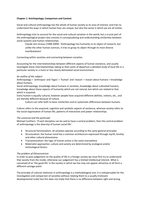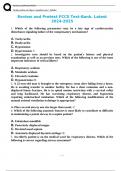Week 0 video 1 & 2
The objective of financial statements is to provide financial info. About the reporting entity that is
useful investors, lenders and other creditors. Also show the results of the management’s stewardship
of the resources entrusted to it.
IFRS provides limited guidance on presentation of income statement. IFRS doesn’t define key metrics
such as EBITDA and EBIT. Reported earnings combine different gains and losses. Accounting earnings
do not always reflect economic performance.
Required income statement items under IFRS: revenue, impairment losses, finance cost, gains/losses
from derecogniztion of financial assets, gains/losses from reclassification of financial assets, share of
results from associates, tax expense, gains/losses from discontinued operations and profit or loss.
IFRS: principle based standards. Advantage, companies can adjust to give a more realistic view.
Disadvantage, the adjustments can make a company look better than it actually is.
Objectives: Transparency, Accountability and Efficiency.
US GAAP, rule-based standards.
Conceptual framework, enables the IASB to issue more useful and consistent pronouncements over
time. It enhances comparability among companies’ financial statements. Makes it more quickly to
solve new practical problems by referring to an existing framework of basic theory.
IFRS and the conceptual framework provide managers with discretion in accounting choices. The
auditor’s opinion answers the questions: does the financial info provide a true and fair view and is it
in accordance with IFRS?
First level – basic objective.
Second level – fundamental concepts. Make decisions based on which alternative provides the most
useful info for decision-making purposes (Decision-usefulness). Useful info must be (only constraint:
cost):
1. Relevant: Predictive, Confirmatory and Material (it must
make a difference, consider both quantitative and
qualitative factors)
2. Faithful representation: Complete, Neutral (don’t select
info to favor one set of interested parties over another),
Free from error.
3. And some enhancing qualities: Comparable (and
consistent), Verifiable (when independent measures
obtain similar results), Timely (info is available before it
loses its capacity to influence decisions), Understandable.
Third level – concepts that implement level one.
Week 1 Lecture 1-1 Ch 18 Revenue Recognition
IFRS 15, is comprehensive and applies to all companies. Comparability and consistency in reporting
revenue should be enhanced. Asset-liability approach (=balance sheet orientation).
Before IFRS 15, there was IAS 18, but it created many differences between the principles-based
(IFRS) and rules-based (GAAP) approaches. Key purpose of IAS 18, define when revenue should be
,recognized. Provided limited guidance, was difficult to apply to complex transactions and didn’t fit
the framework. Under US GAAP and IFRS there are now similar standards.
IFRS 15 improves IFRS and GAAP by:
- Improving comparability
- Simplifying preparation of financial statements
- Providing a more robust framework for addressing revenue recognition issues
- Provide improved disclosures
Disadvantage: There is still judgment involved, such as: how to allocate prices in case of multiple
performance obligations and when to recognize performance obligations are fulfilled.
Revenue recognition principle, recognize revenue in the accounting period when the performance
obligation is satisfied.
Step 1: identify the contract with the customer. Contract, an agreement between two or more
parties that creates enforceable rights or obligations, can be written, oral or implied from customary
business practice. Rights and performance obligations gives rise to an asset or liability.
Components of a valid contract: 1) The contract has commercial substance, 2) Both parties have
approved the contract, 3) Identification of the rights of the parties is established, 4) Payment terms
are identified and 5) It is probable that the consideration will be collected.
Step 2: Identify the separate performance obligation in the contract. Performance obligation, a
promise to provide a distinct product or service to a customer. Steps:
1. The company must provide a distinct product or service. Are the goods interrelated?
2. The company’s products are distinct within the contract. If the performance obligation is not
highly dependent or interrelated with other promises, then each performance obligation
should be accounted for separately.
Step 3: Determine the transaction price.
The transaction price is the amount of consideration that the company expects to receive from a
customer. 2 considerations:
a) Fixed consideration, customer pays fixed amount for the performance obligation
b) Variable consideration, what customers pay depend on future events (e.g. price increase,
volume discounts, performance bonus). Only allocated if it’s reasonably assured that it’ll be
entitled to that amount. Only recognize variable consideration if: 1) they have experience
with similar contracts and 2) are based on experience. Otherwise revenue recognition is
constrained.
Amounts to recognize: 1) expected value (= amounts * probabilities) or 2) most likely amount (the
amount with the highest probability). Only recognize when reasonably can be assured that the
company is entitled to the amount.
Time value of money when considerations involve an interest component (PV).
Non-cash considerations, fair value of what is received. Donations or non-cash items.
Consideration paid or payable to customer (e.g. discounts), decrease the consideration to be
received.
,Step 4: Allocate the transaction price to the separate performance obligations. E.g. allocated cost at
fair value based on the standalone selling price . If this is not possible, use:
- Adjusted market assessment approach, set the price at the estimate of the amount
customers are willing to pay
- Expected cost plus a margin approach
- Residual approach, total transaction price – the sum of the observable standalone selling
prices of other goods in the contract
Step 5: Recognize revenue when each performance obligation is satisfied. Control is obtained when:
the company (1) has the right to payment for the product, (2) has transferred legal title to the
product, (3) has transferred physical possession of the product or the client (4) has significant risks
and rewards of ownership or (5) has accepted the asset.
Revenue recognition can happen at a point in time (most likely) or over time. Over time when:
- The customer receives the consumes the benefits as the seller performs, or
- The customer controls the asset as it is created or enhanced, or
- The company doesn’t have an alternative use for the asset created and either a) the
customer receives benefits as the company performs and therefore the task would not need
to be re-performed or b) the company has a right to payment and this right is enforceable
Most common ways for recording revenues over time: cost-to-cost and units-of-delivery method.
Until performance occurs, no net asset or net liability occurs.
Rolls Royce example: RR sells engines at a
loss and makes a profit on it by providing
maintenance. They used to record the sale
of the engine and the maintenance as one
performance obligation. However, IFRS 15
doesn’t permit the recognition of an asset
for the loss on sale of the engine: there are
two performance obligations. The loss on
the sale of the engine is taken to margin
when the sale occurs. No additional
revenue is recognized in respect of CARs (contractual aftermarket right) under IFRS 15. The
maintenance is a recognized as a revenue over time.
Recognize revenue over time by using percentage-of-completion method (on a cost-to-cost basis).
% complete=costs incurred ¿ date/ most recent estimate of total costs
Revenue( ¿ gross profit )¿ be recognize ¿ date=% complete∗estimated total revenue (¿ gross profit )
Current period revenue ( ¿ gross profit )=revenue ¿ be recognized ¿ date – revenue recognized ∈ prior periods=( p
Or cost-recovery (zero-profit) method. Used when a company is not able to estimate reliably the
outcome of a long-term construction contract, but is confident that it’ll recover the costs incurred.
The method recognizes revenue only to the extent of costs incurred that are expected to be
recoverable. Only after all costs are incurred is gross profit recognized.
Lecture 1-2
Consolidated financial statements, treating the parent and its subsidiaries as a single economic
entity. Subject to IFRS.
, Parent company financial statement, reflects the activities of the parent company and treats the
subsidiaries as financial investments. Prepared in accordance with UK GAAP.
Financial statements:
Balance sheet, consists of assets, liabilities and equity. Is a snapshot of a given point in time. Reflects
company’s decisions.
Asset recognition: probable future economic benefits flowing to the entity. Its cost or value
can be reliably measured.
Current assets, can either be converted to cash or used to pay current liabilities within 12 months.
Non-current assets, intended for continuing use ( >12 months). E.g. goodwill.
Equity, the amount of financing provided by owners of the business and (retained) earnings.
Income statement, evaluate the past performance of the company. Provide a basis for predicting
future performance. Help assess the risk and uncertainty of achieving future cash flows.
Statements of changes in (shareholder’s) equity, shows for each component of equity a reconciliation
between the carrying amount at the beginning and end of the period.
Equity changes through time because of: transactions with shareholders and gains and losses.
Total equity t+ Total comprehensive income for the year +Transactions with shareholders=Total Equity t +1
Cash flow statement, based on receipt or payment of cash. Captures both the current operating
results and the accompanying changes in the balance sheet. It’s useful in determining the short-term
viability of a company. Divided into 3 parts: operating-, investing- and
financing activities.
Direct cash flow statement, starts with cash received from customers.
Indirect cash flow statement, starts with profit (accrual based) and
reverses non-cash items in earnings. Majority uses the indirect way.
Week 2 Lecture 2-1 Ch 10 PPE + 11
Depreciation
IFRS 16: fixed assets.
PPE: 1) for operation (not resale), 2) long term and 3) physical substance. Recognize when: future
economic benefits (extension of useful life increase in quantity produced or increase in quality
produced) and can be measured reliably.
PPE is initially measured at cost, which include: 1) purchase price (at fair value), 2) directly
attributable costs required to bring the asset to the location and condition necessary for it to operate
and 3) initial estimate of costs of dismantling, removing the item or restoring the site (e.g. oilrig).
Improvements with limited lives are incurred as expensed, special assessments (improvements with
indefinite life) are capitalized.
Land price: purchase price, attorney’s fee and recording fee, cost for getting it in condition, liens or
mortgages.
Building cost: material, labor and overhead during construction and professional fees.
Equipment cost: purchase price, insurance during transit, installation and cost of trial runs.
Assigning of overhead cost: assign nothing or assign a portion (full-costing approach)
Interest capitalization. Interest treated as an expense on the income statement. 3 approaches have
been suggested to account for the interest (IAS 23) incurred in financing the construction:
1. Capitalize no interest during construction












